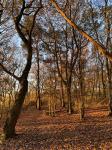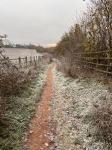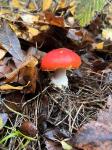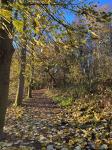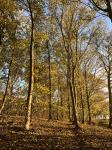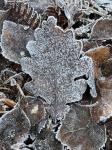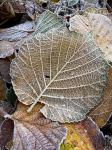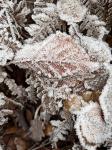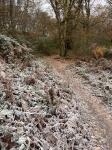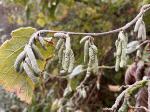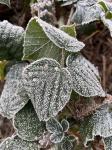Brayton Barff Through the Seasons.
Set in the Vale of York, South West of the market town of Selby and between the villages of Thorpe Willoughby and Brayton, lies Brayton Barff, a sandstone Hill approximately one hundred and fifty feet in height which was formed by glacial movement during the last Ice Age. It is a significant landmark in an otherwise flat landscape.
Today the site is primarily owned by Yorkshire Water with Selby District Council owning a small patch of the land adjacent to the A63 Selby bypass. A large underground reservoir occupies the centre of the site which delivers water to around 4.7 million customers throughout Yorkshire.
Within the Barff woodland over 40% of the trees are Sessile Oak which are generally found in semi natural woodlands in the north of the country. These trees are so called because its acorns are not held on stalks, like those of the English Oak (Pedunculate), but attached directly to the outer twigs. There are also several English Oak trees as well as some cross-hybrid oaks. These trees are known to support many species of flora and fauna, invertebrates, mosses, lichen and fungi.
During the Victorian times it is thought that the shipbuilders on the east coast would come over to the Barff for selected cuts of timber to build their sea going vessels.
The Barff also has a variety of other trees including Silver Birch, Beech, Sycamore, Holly, Rowan, Scots Pine, Alder, Hawthorne and European Larch. There are also several Yew, Willow, Hazel, Horse Chestnut and Wych Elm. As with similar woodlands there are a variety of bushes, including Honeysuckle, Elderberry, Gorse, Broom and Buddleia.
The history of Brayton Barff is quite vague, apparently during 1803 a beacon was lit on the Barff when the country was threatened with an invasion by Napoleon. In May 1935, to celebrate King George V's Silver Jubilee, a Bonfire was lit on the Barff as part of the celebrations.
Early issues of Ordnance Survey Maps dated 1903 clearly show a rifle range on the Barff, extending out to Mill Lane. During the 
Between 2001 – 2004 the A63 Selby bypass, 10km twin lane single carriageway was constructed which severed the South West corner of the Barff, adjacent to Selby Golf Course and resulted in a slight redesign of several holes on the golf course. Wooden fencing was erected as a result of this new road running alongside of the Barff and a footbridge constructed over the ‘new road’ following the line of the Bridal way which extends from Mill Lane. Around 2005/2006 a definite 2metre wide limestone aggregate footpath was laid forming a circular path around the outer edges of the woodland. This footpath is approximately 1.2 miles in length and takes about 30 minutes to circumnavigate at a leisurely pace.
In 2012 the Barff was declared an Ancient Oak Woodland and as such throughout 2012 and 2013 significant work had been carried out by the relevant agencies to cut and remove large swathes of non-native trees, creating at that time huge scars on the landscape. Some three years later the planting of the native trees have become well established and are flourishing. Ongoing maintenance work on the footpath around the bottom of the Barff was completed during the Summer of 2016.
A second phase of woodland maintenance commenced during the Autumn of 2019 with the removal of many old and diseased trees and the cutting back of the Gorse and Broom bushes, especially adjacent to the ‘bypass trail’, this work continued through till March 2020 with re planting continuing into April 2020.
Brayton Barff is a popular site for walkers and bird watchers alike and a path circling the outer perimeter of the Barff makes a pleasant thirty minute walk, giving views looking over towards Selby and the village of Brayton as well as the power stations of Drax and Eggborough..jpg)
For the early risers it is a great place to see some stunning sunrises over the villages of Brayton looking towards Drax Power Station, the same with the Sunsets looking over towards Eggborough and Monk Fryston.
The Barff changes with the Seasons and every visit can reveal something new, the woodland is a haven for wildlife. Records show that since 1982 one hundred and twelve species of bird have been seen in the woodland and at least 40 of those have bred here, including Tawny Owl, Buzzard, Green Woodpecker, Spotted Flycatcher, Goldcrest and Nuthatch to name just a few. On average over 70 species of bird are recorded each year. Further details of the bird life on the Barff can be found on the Brayton Barff Group Facebook page, especially the posts from Derek Cooper. Today ‘The Friends of Brayton Barff group’ led by Derek and a small team of volunteers help keep and maintain the cleanliness of the site as well as recording the wildlife and bird sightings.
The Barff is also home to fifteen different species of mammals, including Muntjac Deer, Pipistrelle Bat, Fox, and Field Vole.
Over eighty species of plant and wildflowers have been recorded, included Bee Orchid, Northern Marsh Orchid, Wood Anemone, Marsh Ragwort, Bluebell, White Bluebell, Bittersweet and Purple and White Foxgloves. Over twenty species of Butterfly have been recorded, including Marbled White, Brown Angus, Speckled Wood, Comma and Brimstone.
During the Autumnal months fungi thrives in this woodland environment, species including Fly Agaric, Beefsteak Tree Fungi, Chicken of the Wood, Sulphur Tufts, Stinkhorn, Ink cap, Puffballs and Hoof Bracket are just some of the many varieties that can be found here.
Click on the galleries shown below to expand the albums.
December 2022
As the year comes to an end, here we are in the heart of winter. Weatherwise we have just about seen all the seasons during December. The month started out wet, having a lot of heavy overnight rain making the footpaths and trails around the Barff exceptionally wet and muddy, this was followed by a week and half of heavy overnight frosts were the temperature dropped to -5C and the daytime temperatures remained in single figures. During the Christmas week we lost the frosts to milder weather, the paths and tracks around the woodland thawed out and became wet and muddy again and we saw temperatures rising to 12C in the late afternoon sunshine, although the occasional overnight frost kept the early morning temperature down. We have only seen a couple of minutes very light snow, which was quite insignificant really. As the month draws to a close, we have had more heavy rain most days, though it has been much milder, my morning dog walks have been quite dull, drizzly and overcast, although the temperature has been between 6C – 8C. Compared to other areas in North Yorkshire who have experienced snow, heavy rain and flooding, we seem to have escaped the worst of the weather, so far.
I have been pleasantly surprised by the variety of fungi in the woodland so late in the year. I photographed some Fly Agaric toadstools on the 3rd December, Sulphur Tufts and Stinkhorns are still showing through too, occasionally I get sight of the delicate ‘Candle Snuff’ growing out of the old rotten tree stumps and ‘Dead man’s fingers’ similarly poking through moss covered tree stumps, though after the frosts during the middle of December they have all but perished.
The autumnal leaves have eventually all but fallen from the trees, many hanging on though till the hard frosts during the middle of the month. On a bright and sunny mornings walk the freshly fallen leaves appear to have formed a large rich blanket of tiny shapes on the ground, golden, red and yellow colours glistening in the morning sunlight. An interesting point I noticed whilst on one of my very early morning walks just recently, my headlamp was picking out the underside of freshly fallen oak leaves, the silver reflective light looking quite surreal as it reflected of the bright light from my headlamp.
Now the leaves have fallen, I have been noticing a lot of Hazel Catkins, they do usually start to appear in the Autumn, although still quite small they are firm to touch and will hang around on the branch through winter as they slowly swell and mature, they are an excellent food source for our winter feeding birds.
The Redpoll have arrived back on the Barff, I saw them at the beginning of December and frequently ever since. They are active foragers, having travelled from the Artic tundra to over winter in this country, I have watched them feeding on catkins in and amongst the birch trees. Although quite a small bird don’t be fooled by their size as Redpolls can survive temperatures of –50 degrees Celsius. A study in Alaska found Redpolls put on about 31 percent more plumage by weight in November than they did in July.
Greater Spotted Woodpeckers are still hard at work and can be heard and seen most days drumming on the tree trunks and branches in their search for food. Robin, Blue and Great Tits can be heard and seen most mornings, as can the Reed Buntings, Chaffinch, Tree Creepers and Long Tailed Tits.
The Buzzard is still active around the woodland, I don’t hear or see it every day but certainly two or three times a week, it can be seen circling around the summit of the Barff as well as the fields around the old pumping station either flying high above the trees or sat contently amongst the upper branches of the trees.
The Grey Squirrels are still active, they don’t hibernate through the winter and can be seen most days whilst walking through the woodlands, either chasing their siblings up and around the tree trunks or along the branches higher up the trees, there was a plentiful harvest of acorns this autumn so they should be able to survive throughout these winter months.
It was good to see that contractors have been on the Barff recently, cutting back some of the clumps of Bramble bushes on the grassy/heathland area, although the growth of the brambles has slowed somewhat during these cooler winter months, unless kept under control will eventually cover the whole of the woodland which we do not want to see.
I will take this opportunity to wish you a very Happy New Year
|



